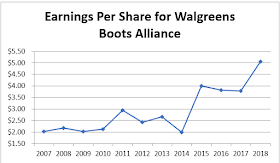Walgreens Boots Alliance, Inc. (WBA) operates as a pharmacy-led health and wellbeing company. It operates through three segments: Retail Pharmacy USA, Retail Pharmacy International, and Pharmaceutical Wholesale.
Walgreens is a dividend champion, with 43 consecutive years of annual dividend increases under its belt.
Over the past decade, Walgreens managed to double earnings per share from $2.03 in 2007 to $5.05 in 2018. The company is expected to earn $6.46/share in 2019.
Growth in earnings per share should come from acquisitions, such as the recent purchase of close to 2,000 Rite Aid stores. This will increase Walgreen’s scale, which could result in a competitive position that results in lower costs for drugs from manufacturers for example. In addition, those acquisitions could result in synergies that add to Walgreen’s bottom line. As a growing portion of population is aging, the amount of prescriptions is only going to increase, offset by the increased penetration of cheaper generic drugs. One of the reasons why I like Walgreen’s and CVS today is the fact that everyone seems to be worried about the potential impact of Amazon disrupting their business model. Based on my research, it would be very difficult for Amazon to replicate the scale of operations in purchasing and efficiently serving clients, the relationships with Pharmacy Benefits Managers, the specialty drug business, and the regulatory hurdles to operate the business in this sector. This is why I believe that the recent weakness is a buying opportunity, since it provides an attractive entry point for long-term investors. This weakness in the share price could also bode well for share buybacks.
Over the past decade, the number of shares outstanding has increased slightly. The company repurchased shares between 2007 and 2012, bringing the total number of shares outstanding from a little over 1 billion shares to 880 million. The subsequent purchase of a 45% stake Alliance Boots in 2012 and the acquisition in 2015 led to an increase in the number of shares to 1.09 billion in 2015. After a few years of buybacks, the number of shares outstanding is down to 995 million.
Over the past decade, the company has managed to increase the amount of its dividends by a factor of five. Walgreen’s paid an annual dividend of 33 cents/share in 2007, which has increased to $1.64/share by 2018. Just a few months ago, the company raised its quarterly dividend by 10% to 44 cents/share.
Walgreen’s was able to increase its dividends at a rate that was higher than earnings growth due to the expansion of its dividend payout ratio. Between 2007 and 2018, the dividend payout ratio increased from 16% to 40%. Going forward, I expect a much smaller room for expansion in the dividend payout ratio than before. However, I would still expect dividend growth to slightly exceed earnings growth over the next decade. But do not expect dividends per share to grow by a factor of five – I would be satisfied with a doubling of the amount of earnings and dividends over the next decade.
I find Walgreen’s to be cheap at 9.80 times forward earnings. The stock yields 2.80% and has a forward payout ratio of 27%. The dividend has a high safety score, and I believe that the stock price reflects the uncertainty that we all hear about in the news. I believe that the low valuation is unwarranted, and would be corrected at some point. If this comes out through a valuation expansion and an increase in earnings power, this could lead to great returns. For long-term accumulators of assets like me however, I am fine if I can continue buying regularly when the stock price is down.
Relevant Articles:
- Should I be adding to CVS and Walgreen’s?
- Three Dividend Growth Stocks Rewarding Shareholders With A Raise
- What drives future investment returns?
- 2019 Dividend Champions List



